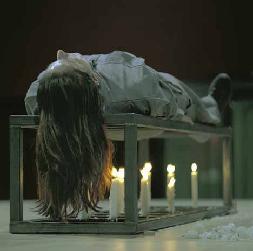Full Frontal Assault: Marina Abramović at MoMA

“I have always staged my fears as a way to transcend them,” remarked performance artist extraordinaire Marina Abramović in a recent profile in The New Yorker. With a new retrospective exhibition at the MoMA in New York—the first they’ve ever given to a performance artist—and a new biography and critical study of her work, Abramović seems fearlessly poised to escape the gulag of contemporary art and spring into the consciousness of the public at large after more than four decades of work.
For those unable to see her in action live, Seven Easy Pieces, a film made of her 2005 series of performances at the Guggenheim, is the next best thing. For an artist who often specializes in shocking full frontal nudity, she seems poised to make a full frontal assault on the world at large.
In that same The New Yorker piece, Abramović traces the roots of her performance art to the self-immolation of Buddhist monk Thich Quang Duc in 1963. To protest the persecution of the Buddhists by the Diem regime in Vietnam, the monk assumed the cross-legged lotus position, doused himself in fuel, and lit himself. He sat almost serenely for ten minutes of excruciating agony—all to prove a point to the world that the world would never forget. Abramović and other artists of the time saw the political potential of such “an art of the ordeal.” Seven Easy Pieces shows Abramović replaying many of those ordeals in an homage not only to her fellow artists but also to the idea of performance art itself.
The film shows Abramović performing Bruce Nauman‘s 1974 Body Pressure, Vito Acconci‘s 1972 Seedbed, Valie Export‘s 1969 Action Pants: Genital Panic, Gina Pane‘s 1973 The Conditioning (pictured), Joseph Beuys‘ 1965 How to Explain Pictures to a Dead Hare, andAbramović’s own 1975 Lips of Thomas and Entering the Other Side, which was newly created specially for the Guggenheim performances.
Although Abramović’s clearly the star of the show, the underrated costars remain the patrons who add to the performance with their reactions, which filmmaker Babette Mangolte captures with sensitivity and understanding—an all-seeing eye that hopes to recreate the experience of being there and, perhaps, compensates with a wider range of vision for the lack of physical proximity. Listening to the din of conversation (and occasional heckling) during Action Pants: Genital Panic, in which the artist sits in a leather jacket and crotchless pants while holding an assault rifle, you may not feel as uncomfortable as if she were sitting there before you in the flesh, but you still feel the unease. When the Belgrade-born Abramović performs her own Lips of Thomas, which features flagellation, self-mutilation, and a cross made of ice as metaphors for the long, tragic history of the Slavic people, even the distance of video cannot save you from suffering with her and empathizing with her.
By recreating Nauman’s, Acconci’s, and Beuys’ performances, Abramović struck a great blow for the acceptance of performance art as a museum art to be preserved for generations, while still acknowledging the power of performance as a living art. For anyone unfamiliar with the history of performance art, Seven Easy Pieces stands as the “textbook” introduction to the genre. It’s the perfect introduction and preparation for the MoMA retrospective, when Abramović presents her own greatest hits with the assistance of a corps of young helpers.
Abramović will be present herself at the MoMA show, which is titled “The Artist Is Present.” For the entire run of the show, until May 31st, Abramović will sit at a table and invite members to sit in a chair opposite her to “exchange energy.” If you can’t make it to New York this Spring to exchange energy with Abramović in person, Seven Easy Pieces will let you feel her energy and your own emerging empathy. In that exchange, the artist is present, but we the viewers are present, both in mind and soul, as well.
[Image: Abramović performing Gina Pane‘s 1973 The Conditioning.]
[Many thanks to Microcinema for providing me with a review copy of Seven Easy Pieces.]





